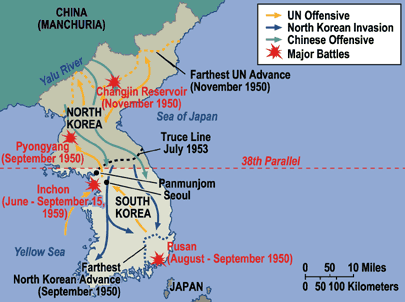International Relations
American Sanctions Over North Korea
- 13 Jan 2022
- 6 min read
For Prelims: North Korean missile launches, 38th parallel, Korean Armistice Agreement.
For Mains: Korean War, Korean Armistice Agreement , Cold War, Non-Proliferation Treaty (NPT) in 2003, THAAD (Terminal High Altitude Area Defence), American Sanctions Over North Korea.
Why in News
Recently, the US has imposed its first sanctions over North Korea’s weapons programs following a series of North Korean missile launches.
- These sanctions were aimed both to prevent the advancement of North Korea’s programs and to impede its attempts to proliferate weapons technologies.
- North Korea is continuing its missile program despite several UN Security Council resolutions and the international community’s calls for diplomacy and denuclearization.
Key Points
- Origin of Divide in Korean Peninsula:
- The present-day conflict between the US and North Korea can be traced from the Cold War between the USSR and US.
- After the defeat of Japan in World War II, the Allied forces at the Yalta Conference (1945), agreed to establish a “four-power trusteeship over Korea”.
- The fear of the spread of communism (state ownership over economic resources of a country) and the mutual distrust between the USSR and the US led to the failure of the trusteeship plan.
- Before a concrete plan could be formulated, the USSR invaded Korea.
- This led to a condition where the north of Korea was under the USSR and the south under the rest of the allies, mainly the US.
- The Korean peninsula was divided into two regions by the 38th parallel.
- In 1948 the United Nations proposed free elections across all of Korea.
- The USSR rejected this plan and the northern part was declared as Democratic People’s Republic of Korea (North Korea).
- The election took place in the American protectorate resulting in the establishment of the Republic of Korea (South Korea).
- Both North Korea and South Korea tried to enhance their reach, territorially and ideologically, which gave birth to the Korean Conflict.
- The Korean War:
- On 25th June 1950, North Korea, backed by the USSR, launched an attack on South Korea and occupied most of the country.
- In response, the United Nations force led by the US retaliated.
- In 1951 the US forces led by Douglas MacArthur crossed the 38th parallel and triggered the entry of China in support of North Korea.
- To prevent further escalation, peace talks began later in 1951.
- India was actively involved in negotiating peace in the Korean peninsula by engaging all the major stakeholders – US, USSR and China.
- In 1952, the Indian resolution on Korea was adopted at the United Nations (UN).
- On 27th July 1953, the Korean Armistice Agreement was signed between the UN Command, the Korean People's Army and the Chinese People's Volunteer Army.
- It led to an official ceasefire without a Peace treaty. Thus, the war officially never ended.
- This also led to the establishment of the Korean Demilitarised Zone (DMZ) – a strip of land running across the Korean Peninsula to serve as a buffer zone between North Korea and South Korea.
- In December 1991, North and South Korea signed a pact agreeing to refrain from aggression.
- On 25th June 1950, North Korea, backed by the USSR, launched an attack on South Korea and occupied most of the country.
- US-North Korea Conflict:
- During the Cold War era, (allegedly with the support of Russia and China) North Korea accelerated its nuclear programme and developed nuclear capabilities.
- During the same time, the US extended its Nuclear Umbrella (guarantee of support during a nuclear attack) to its allies i.e South Korea and Japan.
- North Korea withdrew from the Non-Proliferation Treaty (NPT) in 2003 and afterwards, under present leader Kim Jong-un, it increased nuclear missile testing.
- North Korea is barred from testing ballistic missiles and nuclear weapons under international law.
- In response to this, the US started deploying THAAD (Terminal High Altitude Area Defence) in South Korea in March 2017.
- The territorial conflict which started between North and South Korea has transformed into a tussle between the US and North Korea.
- Following the failure of diplomatic efforts to improve relations with North Korea, the US has imposed sanctions.
- During the Cold War era, (allegedly with the support of Russia and China) North Korea accelerated its nuclear programme and developed nuclear capabilities.
- India’s Stand:
- India has consistently voiced its opposition to North Korean nuclear and missile tests. However, it has maintained a neutral stance regarding sanctions.





